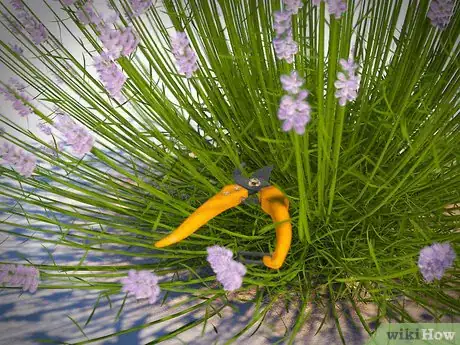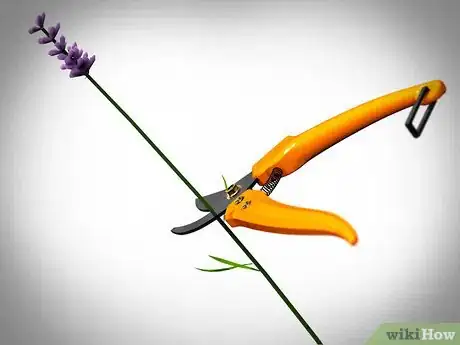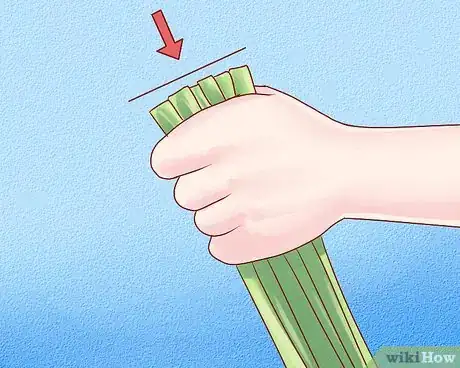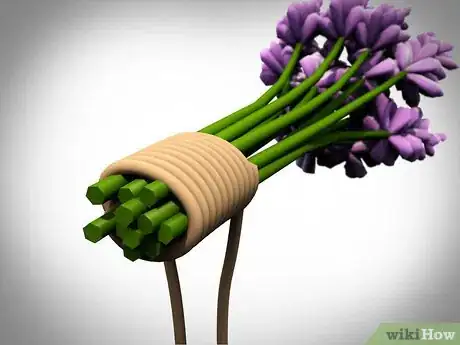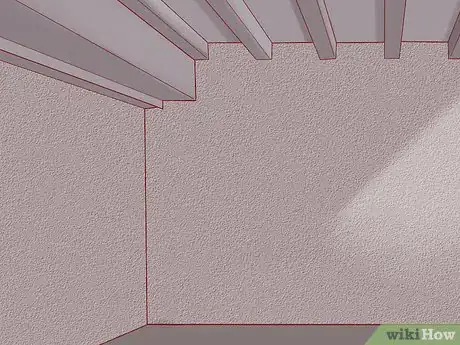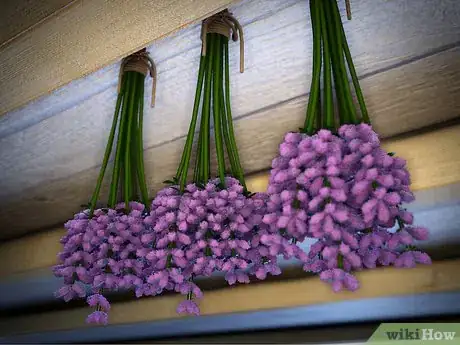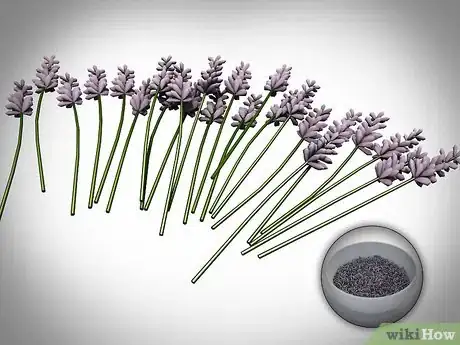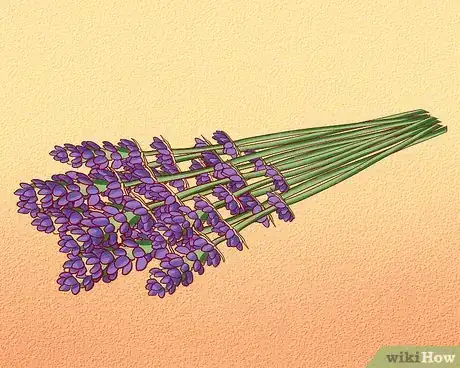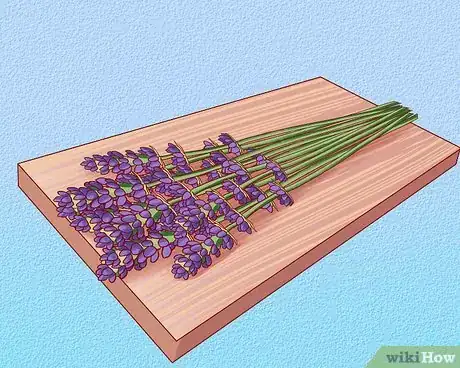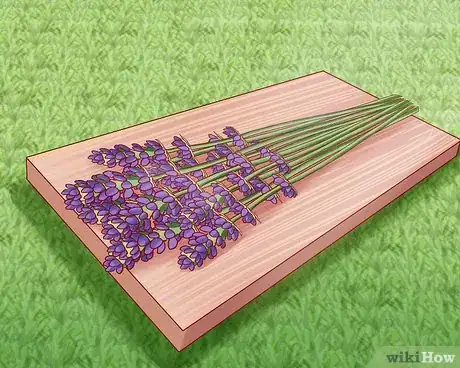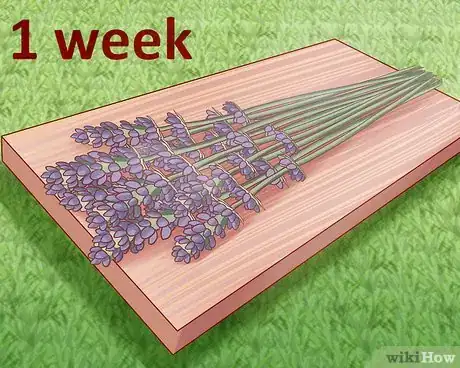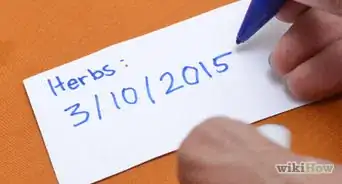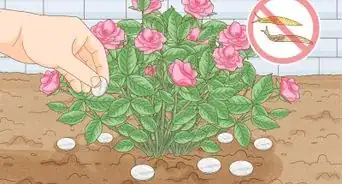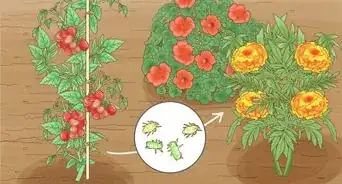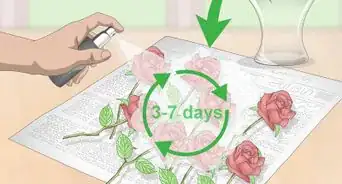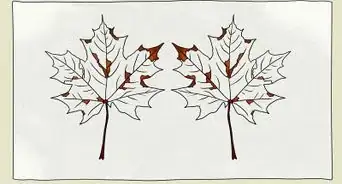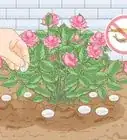This article was co-authored by Lauren Kurtz. Lauren Kurtz is a Naturalist and Horticultural Specialist. Lauren has worked for Aurora, Colorado managing the Water-Wise Garden at Aurora Municipal Center for the Water Conservation Department. She earned a BA in Environmental and Sustainability Studies from Western Michigan University in 2014.
There are 8 references cited in this article, which can be found at the bottom of the page.
wikiHow marks an article as reader-approved once it receives enough positive feedback. This article received 19 testimonials and 96% of readers who voted found it helpful, earning it our reader-approved status.
This article has been viewed 658,515 times.
Delicate, fragrant lavender is easy to dry and preserve so that it may be used in scented sachets or as part of a dried flower arrangement. To dry lavender, it's important to harvest the flowers at the right moment, when their color is most brilliant and their scent strongest. You can then choose to dry the flowers in a dark room or in the sun, depending on their intended use. Read on to learn how to dry lavender two different ways.
Steps
Drying Lavender in a Dark Room
-
1Harvest the lavender before it's fully in bloom. Cut the lavender at the base of the stem right before the buds open. This will ensure that the dried lavender will retain a strong floral scent and remain it's bright purple color.[1]
-
2Cut matured lavender flowers just above the leaves. Aim to get the longest stem possible on the flower. In harvesting lavender you are also pruning the plant, which helps it grow strong throughout the winter.[2]
- The plant will need the leaves and stem to finish the growing season, so make sure to leave them in place.
Advertisement -
3Gather the lavender into a bunch. Once you've harvested a good handful, gather it into a bunch. Cut the bottom off of the bunch so the ends are even.[3]
-
4Tie the stems with a rubber band. Keep bundles ¾” around or smaller so that they will dry evenly. This will help prevent mold and mildew growth. Wind the rubber bands toward the base of the stems. Keep winding until the stems are tightly secured, but not crushed.[4]
- Using a rubber band instead of string or ribbon will ensure that the stems won't slip from the tie as they shrink during the drying process.
-
5Find a dark place to dry the lavender. Drying lavender slowly in the dark is the best way to preserve its color, since the sun will fade the purple flowers. Look for a dry, dark place that doesn't get much sunlight, such as your shed, garage, or a shaded place under your eaves.[5]
-
6Hang the lavender bunch upside down. Loop a strand of the rubber band over a hook or nail. You can also tie a string from the rubber band to a hook or rack to hang the lavender, or you can partially unwind a paperclip and use that to hook the rubber band to a rope, chain, or hook.[6]
-
7Let the lavender dry for 2 - 4 weeks.[7] Check every so often to see when the lavender is dry. When you brush the flowers, they should fall easily from the stems. You can leave the flowers on the stems or brush them off to use in sachets or for baking.
Drying Lavender in the Sun
-
1Harvest the lavender. Harvest lavender just before the buds open. Cut at the base of the stems to preserve as much stem as possible.
-
2Lay the lavender on a block of wood. A cutting board or another large piece of wood is perfect for drying lavender in the sun. If you use a metal tray, the lavender will get too hot; if you use plastic, you might have a melted mess on your hands.
-
3Place the lavender in a sunny spot. Move the cutting board or wood block to a place that gets plenty of sun, either indoors or outdoors. Drying lavender this way is a much quicker process than drying it in the dark, but be prepared for the sun to fade the lavender to a very pale purple color.
- If you live in an area that gets a lot of rain, either dry the lavender inside near a sunny window or be ready to move it inside when the clouds threaten to break.
-
4Allow the sun to completely dry the lavender. It should take under a week for the hot sun to dry the lavender. Check every few days to see whether the lavender is dry. When it's ready, the flowers should crumble easily from the stems.
Expert Q&A
Did you know you can get expert answers for this article?
Unlock expert answers by supporting wikiHow
-
QuestionHow long does lavender stay fresh?
 Lauren KurtzLauren Kurtz is a Naturalist and Horticultural Specialist. Lauren has worked for Aurora, Colorado managing the Water-Wise Garden at Aurora Municipal Center for the Water Conservation Department. She earned a BA in Environmental and Sustainability Studies from Western Michigan University in 2014.
Lauren KurtzLauren Kurtz is a Naturalist and Horticultural Specialist. Lauren has worked for Aurora, Colorado managing the Water-Wise Garden at Aurora Municipal Center for the Water Conservation Department. She earned a BA in Environmental and Sustainability Studies from Western Michigan University in 2014.
Professional Gardener
-
QuestionI tied my lavender up to dry under a large juniper canopy shaped tree, where it gets almost no sun and a good breeze. If it rains, will it mold?
 Lauren KurtzLauren Kurtz is a Naturalist and Horticultural Specialist. Lauren has worked for Aurora, Colorado managing the Water-Wise Garden at Aurora Municipal Center for the Water Conservation Department. She earned a BA in Environmental and Sustainability Studies from Western Michigan University in 2014.
Lauren KurtzLauren Kurtz is a Naturalist and Horticultural Specialist. Lauren has worked for Aurora, Colorado managing the Water-Wise Garden at Aurora Municipal Center for the Water Conservation Department. She earned a BA in Environmental and Sustainability Studies from Western Michigan University in 2014.
Professional Gardener Yes, it probably would get mold or at least dampen some. Rather than risk rehydration or mold, bring lavender inside when it looks like it might rain, or keep your lavender inside to dry. Depending on the thickness of your juniper canopy, some water will still penetrate through the needles and might drip down the trunk and onto your bundle.
Yes, it probably would get mold or at least dampen some. Rather than risk rehydration or mold, bring lavender inside when it looks like it might rain, or keep your lavender inside to dry. Depending on the thickness of your juniper canopy, some water will still penetrate through the needles and might drip down the trunk and onto your bundle. -
QuestionHow can I prevent mold?
 Lauren KurtzLauren Kurtz is a Naturalist and Horticultural Specialist. Lauren has worked for Aurora, Colorado managing the Water-Wise Garden at Aurora Municipal Center for the Water Conservation Department. She earned a BA in Environmental and Sustainability Studies from Western Michigan University in 2014.
Lauren KurtzLauren Kurtz is a Naturalist and Horticultural Specialist. Lauren has worked for Aurora, Colorado managing the Water-Wise Garden at Aurora Municipal Center for the Water Conservation Department. She earned a BA in Environmental and Sustainability Studies from Western Michigan University in 2014.
Professional Gardener Keep your bunches around ¾” or smaller so that air flows to the middle of the bundle. If you want a larger bundle, combine small bundles after drying. Inside or outside your lavender bundle will need to be in a consistently dry place at all times. Any extra moisture in the air risks rehydrating your bundle. Be especially careful in damp humid climates. Using a fan or a dehumidifier inside the drying room will help keep bundles dry and mold free. When drying bundles outside, keep an eye out for rain in the forecast and bring inside to a sunny window.
Keep your bunches around ¾” or smaller so that air flows to the middle of the bundle. If you want a larger bundle, combine small bundles after drying. Inside or outside your lavender bundle will need to be in a consistently dry place at all times. Any extra moisture in the air risks rehydrating your bundle. Be especially careful in damp humid climates. Using a fan or a dehumidifier inside the drying room will help keep bundles dry and mold free. When drying bundles outside, keep an eye out for rain in the forecast and bring inside to a sunny window.
References
- ↑ http://damselindisdress.wordpress.com/2009/06/19/how-to-dry-lavender/
- ↑ http://gardentherapy.ca/harvesting-english-lavender
- ↑ https://www.youtube.com/watch?v=wW-XmNKajQk
- ↑ http://gardentherapy.ca/harvesting-english-lavender/
- ↑ https://www.youtube.com/watch?v=_Ys8SxIgGj4
- ↑ https://purplehazelavender.com/lavender/drying-lavender/
- ↑ https://www.tumalolavender.com/article-fresh-to-dried-lavender.htm
- ↑ https://www.apartmenttherapy.com/how-to-prevent-get-rid-of-fabr-109733
About This Article
To dry lavender, first harvest it by cutting it at the base of the stems just before the buds open. Then lay the lavender on a wooden cutting board or a block of wood. Leave it in the sun outside or in a sunny spot in your house for about a week, or until the flowers crumble easily. If you'd prefer to dry the lavender inside, tie it in a bunch with a rubber band. Then hang it upside down in a dark, dry place, like your garage, for 2-4 weeks. For more information from our Horticultural reviewer on how to dry lavender while keeping its vibrant color intact, read on!
